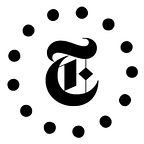Why Having a Diverse Team Will Make Your Products Better
By MODUPE AKINNAWONU
In March, The New York Times published an article about how hard navigating the subway can be in a wheelchair, and it touched me a lot more than I thought it would when I started reading it. Months later, it’s still on my mind. The piece was penned by Sasha Blair-Goldensohn, an engineer from Google who had an accident that left him partially paralyzed. As he started navigating the city on wheels he discovered that “inflexible bureaucracies with a ‘good enough’ approach to infrastructure and services can disenfranchise citizens with disabilities, many of whom cannot bridge these gaps on their own.”
Most subway stations in New York are not wheelchair accessible, and the ones that are often have broken elevators that can leave commuters stranded above or below ground. I’d like to imagine what the considerations for how to build an accessible subway system would be if there were more people with disabilities on the teams that make these decisions. It seems like more thoughtful accessibility would make everyone’s experience with this public product better.
It’s so exciting for me to see the ways in which the conversation about diversity and its impact on product development is accelerating. Diversity comes in many forms, and can include characteristics that are innate or acquired, such as country of birth, being multilingual, degree of abledness, race and socioeconomic background, among others. Having less homogenous teams makes us more innovative, can make us smarter and increases profits.
Product Successes
The variety of perspectives that come from diverse teams help make products stronger, and ultimately serve users better.
Companies with more women are more likely to introduce radical new innovations into the market (hello, Rent the Runway and Stitch Fix!) and companies with a culturally diverse leadership team are more likely to develop new products.
Slack celebrated their diversity very publicly last year when they sent four black female engineers to accept their award from TechCrunch for fastest rising startup.
Sallie Krawcheck started Ellevest in response to an investing industry that was primarily “by men, for men” and kept women from achieving their financial goals. Halla Tómasdóttir steered financial services firm Audur Capital through the financial storm in Iceland by applying traditionally “feminine” values.
And after almost 60 years, Barbies finally come in different shapes, sizes, skin tones and eye color in an effort to attract a wider demographic and increase sales.
Product Failures
Without diverse perspectives and experiences in designing, building and testing, products can and will fail female and minority users.
Some of the first air bags to be installed cars failed to protect women because they were built to men’s specifications, tested with male crash test dummies, and didn’t take the female anatomy into account. The first voice recognition programs didn’t recognize female voices or many accents because they were built and tested by men and native English speakers. You may remember Google Photos’ image recognition software labeled two black people as “gorillas.” When Apple first launched their Health app, there was one glaring exception to their promise to “monitor all of your metrics that you’re most interested in”: it didn’t track menstruation. And some phones are even too big for women’s hands.
Remember Microsoft’s paperclip office assistant? The company spent $100k on market testing and ignored female participants’ feedback that the characters were too male (90% of women didn’t like the characters). The reaction was largely rejected because the men leading the project couldn’t see the issue themselves; they shipped the product with 10 male characters and 2 female characters.
One of the hardest things to remember when building products is that you are not your user.
Tips for Building Better Products
Staffing teams with people who think differently from one another can remind us of our blind spots and hopefully lead us to better solutions for all users. Here are some things you can do to make better products:
- Great products start with great teams, so ensure you have a diverse team to design, build and test your products.
- Create spaces that guarantee everyone’s voice is heard by remembering that not everyone likes to speak up in meetings. Set agendas ahead of time so everyone can contribute; create space in group meetings for individual brainstorming; and provide other channels for feedback.
- Cultivate an environment that includes psychological safety: this allows team members to take risks and speak up when they have novel or particularly unorthodox ideas.
- Talk to users! If organizing in-house user testing is too difficult, ensure users can submit feedback via email and then make sure time is dedicated to reading some of their responses. Regularly check the public feedback you get in Google Play or the App Store. To make keeping up with these messages simpler, consider setting up a bot that sends these messages to a Slack channel.
- Reading user feedback makes it harder for you to ignore user needs that you don’t personally feel. It can be easy to make assumptions when building a product, but listening to users whose experiences are different from your own can highlight issues you may not have encountered.
With a less homogenous mix of voices at the table, imagine what we can build! If you’re hiring for digital teams and having trouble figuring out ways to diversify your staff, there are numerous organizations you can partner with, including Coalition for Queens, Code 2040 and Power to Fly.
Modupe Akinnawonu is a product manager at The New York Times. She focuses on their Android news app, among other projects.
